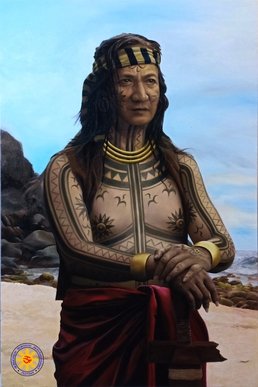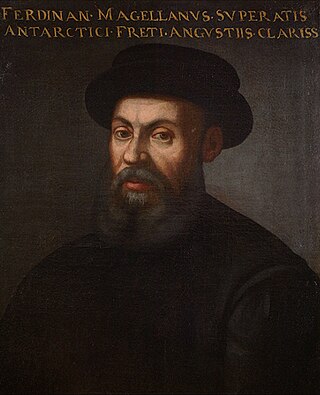
The 16th century began with the Julian year 1501 and ended with either the Julian or the Gregorian year 1600 (MDC), depending on the reckoning used.

Miguel López de Legazpi, also known as El Adelantado and El Viejo, was a Spanish conquistador who financed and led an expedition to conquer the Philippine islands in the mid-16th century. He was joined by Guido de Lavezares, relative Martin de Goiti, friar Andrés de Urdaneta, and his grandsons Juan and Felipe de Salcedo, in the expedition. Legazpi established the first Spanish settlement in the East Indies after his expedition crossed the Pacific Ocean, arriving in Cebu in 1565. He became the first Governor-General of the Spanish East Indies, which was administered from New Spain for the Spanish crown. It also encompassed other Pacific islands, namely Guam, the Mariana Islands, Palau, and the Carolinas. After obtaining peace with various indigenous tribes and kingdoms, he made Cebu City the capital of the Spanish East Indies in 1565 and later transferred to Manila in 1571. The capital city of the province of Albay bears his name.

The Battle of Mactan was a battle fought on a beach in Mactan Island between the Spanish forces led by the Portuguese explorer Ferdinand Magellan along with local allies, and Lapulapu, the chieftain of the island, on the early morning hours of April 27, 1521. Magellan, a Portuguese-born commander serving the Spanish Empire who led an expedition that ultimately circumnavigated the world for the first time, commanded a small Spanish contingent in an effort to subdue Mactan led by Lapulapu under the Spanish crown. The sheer number of Lapulapu's forces, compounded with issues on the location and armor, ultimately resulted in a disastrous defeat to the Europeans and the death of Magellan. Surviving members of Magellan's crew continued the expedition under the command of Juan Sebastian de Elcano, who completed the journey in September 1522.

Lapulapu or Lapu-Lapu, whose name was first recorded as Çilapulapu, was a datu (chief) of Mactan.

Andrés de Urdaneta was a maritime explorer for the Spanish Empire of Basque heritage, who became an Augustinian friar. At the age of seventeen, he formed part of the Loaísa expedition to the Spice Islands where he spent more than eight years. Around 1540 he settled in New Spain and became an Augustinian friar in 1552. At the request of Philip II he joined the Legazpi expedition for a return to the Philippines. In 1565, Urdaneta discovered and plotted an easterly route across the Pacific Ocean, from the Philippines to Acapulco in the Viceroyalty of New Spain. The route made it practical for Spain to colonize the Philippines and was used as the Manila galleon trade route for more than two hundred years.
Alonso de Arellano was a 16th-century Spanish explorer who commanded one ship that was part of the fleet that re-discovered the Philippines after the Magellan and López de Villalobos expeditions.
Datu Sikatuna was a Datu or chieftain of the Bool Kingdom in the island of Bohol in the Philippines. He made a blood compact (sanduguan) and alliance with the Spanish explorer Miguel López de Legazpi on March 25, 1565 at Hinawanan Bay, barangay Hinawanan, Loay. Their blood compact is the first Treaty of Friendship between Spain and the Philippines. The previous site of the pact was thought to have been at barangay Bool, Tagbilaran City but later a panel of historians concluded that the event actually happened at barangay Hinawanan, Loay, Bohol as ratified through Resolution No. 4, issued by the National Historical Institute in 2005.
Rajah Tupas was the last Rajah of Cebu in the Pre-Hispanic Indianized polity of Philippines. He was the son of Sri Parang the Limp, and the cousin of Rajah Humabon. He is known to have been baptized under duress on March 21, 1568, at age 70, placing his birthdate at about 1497. He ruled Cebu with his peers until he was defeated by Miguel López de Legazpi's soldiers on April 27, 1565. On June 4, 1565, Tupas and Legaspi signed the Treaty of Cebu, which effectively gave Spain suzerainty over Cebu. He died later in 1568.

Guido de Lavezaris was the second Spanish Governor General of the Philippines. He succeeded Miguel López de Legazpi in 1572 as governor, and was succeeded by Francisco de Sande on August 25, 1575.

The Spanish East Indies were the overseas territories of the Spanish Empire in Asia and Oceania from 1565 to 1899, governed for the Spanish Crown from Mexico City and Madrid through the captaincy general which ruled Manila.

The Captaincy General of the Philippines was an administrative district of the Spanish Empire in Southeast Asia governed by a governor-general as a dependency of the Viceroyalty of New Spain based in Mexico City until Mexican independence when it was transferred directly to Madrid.

The Legazpi-Sikatuna Blood Compact or Sandugo was a blood compact, performed in the island of Bohol in the Philippines, between the Spanish explorer Miguel López de Legazpi and Datu Sikatuna, chieftain of Bohol, on March 16, 1565, to seal their friendship following tribal tradition. This is considered the first treaty of friendship between the Spaniards and Filipinos. "Sandugo" is a Visayan word which means "one blood".

Blood compact was an ancient ritual in the Philippines intended to seal a friendship or treaty, or to validate an agreement. The contracting parties would cut their hands and pour their blood into a cup filled with liquid, such as wine, and drink the mixture.

The Archdiocese of Cebu is a Latin Church archdiocese of the Catholic Church in the Philippines and one of the ecclesiastical provinces of the Catholic Church in the country. It is composed of the entire civil province of Cebu. It is the Mother Church of the Philippines. The jurisdiction, Cebu, is considered as the fount of Christianity in the Far East.

Ferdinand Magellan ( mə-GHEL-ən or mə-JEL-ən; Portuguese: Fernão de Magalhães, IPA:[fɨɾˈnɐ̃w̃dɨmɐɡɐˈʎɐ̃j̃ʃ]; Spanish: Fernando de Magallanes, IPA:[feɾˈnandoðemaɣaˈjanes]; was a Portuguese explorer best known for having planned and led the 1519 Spanish expedition to the East Indies across the Pacific Ocean to open a maritime trade route, during which he discovered the interoceanic passage thereafter bearing his name and achieved the first European navigation to Asia via the Pacific.

The known recorded history of the Philippines between 900 and 1565 begins with the creation of the Laguna Copperplate Inscription in 900 and ends with the beginning of Spanish colonization in 1565. The inscription records its date of creation in the year 822 of the Hindu Saka calendar, corresponding to 900 AD in the Gregorian calendar. Therefore, the recovery of this document marks the end of the prehistory of the Philippines at 900 AD. During this historical time period, the Philippine archipelago was home to numerous kingdoms and sultanates and was a part of the theorized Indosphere and Sinosphere.

The Treaty of Zaragoza or Saragossa, also called the Capitulation of Zaragoza or Saragossa, was a peace treaty between Castile and Portugal, signed on 22 April 1529 by King John III of Portugal and the Habsburg emperor Charles V in the Aragonese city of Zaragoza. The treaty defined the areas of Castilian and Portuguese influence in Asia in order to resolve the "Moluccas issue", which had arisen because both kingdoms claimed the lucrative Spice Islands for themselves, asserting that they were within their area of influence as specified in 1494 by the Treaty of Tordesillas. The conflict began in 1520, when expeditions from both kingdoms reached the Pacific Ocean, because no agreed meridian of longitude had been established in the far east.

The 1570 Battle of Manila was fought in Manila between Luzonians, led by Prince Sulayman, and Spaniards, led by field marshal Martin de Goiti, on 24 May 1570. Goiti's forces eventually besieged the fort of Manila, destroyed Manila, and won the battle, with the site of the fort falling to the Kingdom of the Spains and the Indies. The Spaniards then founded a Spanish city of Manila making it the capital of the Spanish East Indies.
The Treaty of Cebu is a peace treaty signed on June 4, 1565 between Miguel López de Legazpi, representing King Philip II of Spain, and Rajah Tupas of Cebu. The treaty effectively created Spanish suzerainty over Cebu.

The first documented Catholic Mass in the Philippines was held on March 31, 1521, Easter Sunday. It was conducted by Father Pedro de Valderrama of Ferdinand Magellan's expedition along the shores of what was referred to in the journals of Antonio Pigafetta as "Mazaua".
















